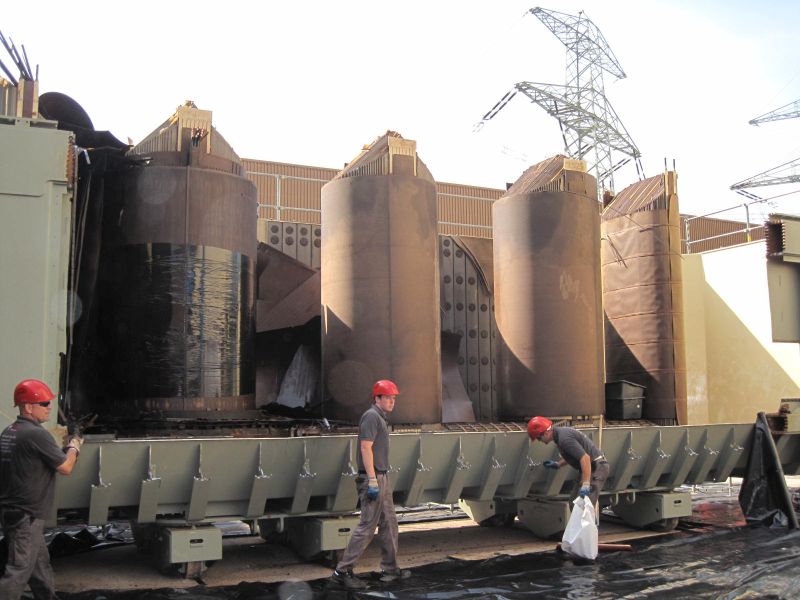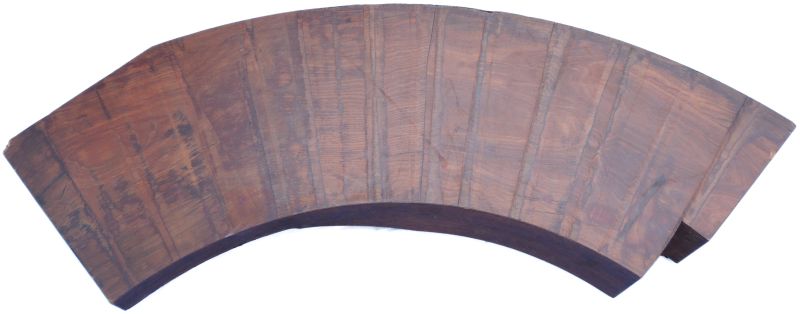Reliable into advanced old age?
How good is Lignostone® Transformerwood® after 30 years?
If you believe that old age leads to lower performance, you may well be wrong. For proof of the contrary, Dennis Hoppmann, Marketing & Technology of BU Composites at Röchling Engineering Plastics KG in Haren, entered the sealed area of a nuclear power station (NPS).
The last hour struck for an old power transformer at the foot of a cooling tower in the Grohnde Nuclear Power Station in Lower Saxony/Germany. It had been in operation for 32 years. It was now being scrapped bit by bit. Several thousand litres of oil were bled off, disc grinders whirred, components demolished and ended up in containers in a sealed area. The workers of a company specialised in dismantling power transformers used all their skill in this work.
The Nuclear Power Station in Lower Saxony exchanged two old 750 MVA power transformers according to schedule in July 2013. They were constructed with components made of Röchling's insulation material Lignostone® Transformerwood® at the beginning of the 80ies and had been in continuous operation since then. Dennis Hoppmann was also on the spot during scrapping. He is responsible for power transformer construction in BU Composites at Röchling's and wanted to collect some of the old components made of Lignostone® Transformerwood®. The electrical engineer wanted to know how the properties of the components made of the Röchling material had changed in application over 30 years. The results from the company's own materials laboratory in Haren would turn out to be noteworthy.

Premiere – never done before
Röchling has been manufacturing insulating components made of Lignostone® Transformerwood® such as support rings, stepped blocks and pressure bars for high-voltage transformers since the fifties. Leading power transformer manufacturers from all over the world have been relying on this high-performance material for decades now. There had not, however, been the opportunity to thoroughly examine the material properties after 30 years' operation up till now. "Power transformers have a service life of 30 to 40 years. We do not hear from the energy suppliers, operating the transformers, when they are exchanged, and therefore hardly have the chance to get the components for inspection", says Hoppmann. Thanks to good contacts, the engineer now had the opportunity, however, to be at Grohnde when the power transformer was dismantled there.
He was only allowed into the nuclear power station with strict security restrictions, identity and car checks including trailer being observed. He selected suitable components for examination and brought them to Haren. "We are able to examine the long-term ageing behaviour of the material in detail for the very first time. Such inspections have never been conducted to date - so it's a genuine premiere", he made the special situation clear.
Unique properties
Lignostone® Transformerwood® is the ideal material for building oil-filled power transformers. In the power transformer, however, various factors influence the performance capability of the components concerned. The laminated densified wood comprises selected red beech veneers, glued with phenolic resin, compressed under pressure and heat and made composite. Amongst all the known woods, the wood of the red beech (Fagus sylvatica) possesses the best electrical and mechanical strength for application as insulation material in oil-filled power transformers. This material is characterised by outstanding electrical insulation, withstands high mechanical loads, has a low specific weight and very good oil absorption through open capillaries in the wood.
Influencing factors
However, in the power transformer, the operating temperatures - between 90° and 110° Celsius depending on the load, the electrical loading, moisture and air influence the ageing behaviour of the material and are capable of altering the electrical and mechanical properties. Should a material not withstand these conditions permanently, the power transformer may become inoperative or be damaged irreparably. Operating failure and the thus ensuing losses in income, any recourse claims as well as the premature, short-term new acquisition would be catastrophic for the operator. This is why a reliable material with outstanding properties is indispensable for building power transformers.
Reliable even after 30 years
The old components made of Lignostone® Transformerwood® were subjected to tests in the laboratory at the Haren location. How well have they got over the influences over three decades? You clearly see the long years of application on the outside. Contact with oil has made them darker. What is decisive, however, are the mechanical and electrical properties. Are they just as good in "old age" as with the new material?
The modulus of elasticity, flexural strength, compressive strength and electrical strength were also measured. The upshot: Outstanding. "All the figures determined lie only slightly below or partly above the average values of new material. In any event, they are still within the scattering usual for this natural material", Hoppmann explained the test results. "Even after 30 years, Lignostone® Transformerwood® is still an absolutely reliable material."












